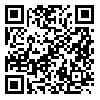Volume 15, Issue 7 (9-2015)
Modares Mechanical Engineering 2015, 15(7): 336-344 |
Back to browse issues page
Download citation:
BibTeX | RIS | EndNote | Medlars | ProCite | Reference Manager | RefWorks
Send citation to:



BibTeX | RIS | EndNote | Medlars | ProCite | Reference Manager | RefWorks
Send citation to:
Bamdad M, Taheri F. Improvement of End-effector Orientability Capability in a Serial-parallel Cable Robot. Modares Mechanical Engineering 2015; 15 (7) :336-344
URL: http://mme.modares.ac.ir/article-15-12056-en.html
URL: http://mme.modares.ac.ir/article-15-12056-en.html
1- Iran
Iran
Abstract: (5130 Views)
In this paper, a hybrid model which consists of planar parallel robot with a 2-DOF arm is presented. This manipulator is based on cable parallel robots and a kinematic serial chain is utilized and added to a cable parallel chain. The hybrid manipulator can provide features of both serial and parallel mechanism. Understanding the orientability of the end-effector within this workspace gives a measure of the ability of the robot to perform manipulation tasks. Most underactuated parallel manipulators have a low rotational capability. To overcome it, this paper focuses its attention on a new family of serial-parallel manipulators. The initial goal of this design is to increase the orientability capability of a planar two-cable robot. The kinematic and dynamic analysis of this new type hybrid manipulator is presented. The dynamic modeling is performed by using a combination of Lagrange and Newton-Euler methods. This paper conducts the dynamic trajectory planning study to a novel design for the cable robots. In fact, time optimal trajectory planning is a strategy that is used to verify this new design. Two models are considered in the simulation part. A novel hybrid model is compared to a planar parallel cable robot. It is verified that the proposed design allows significantly reduced actuation energy and improved orientability capability compared to the parallel robot.
Article Type: Research Article |
Subject:
robatic
Received: 2015/04/9 | Accepted: 2015/05/10 | Published: 2015/06/14
Received: 2015/04/9 | Accepted: 2015/05/10 | Published: 2015/06/14
| Rights and permissions | |
 |
This work is licensed under a Creative Commons Attribution-NonCommercial 4.0 International License. |







